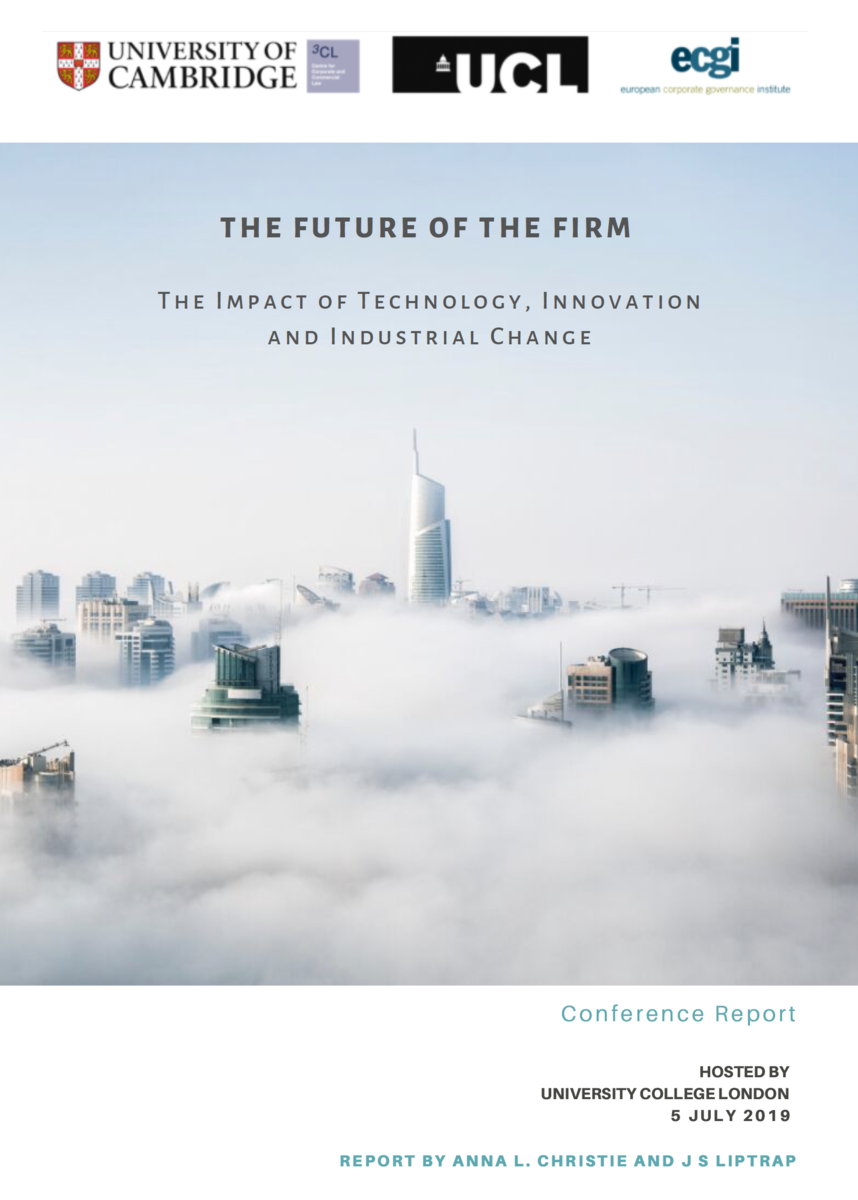Event Report: The Future of The Firm

Speculation, caution, enthusiasm, prediction, and philosophy: a recent event on "The Future of the Firm" captured all of the aforementioned elements and made for an informed exchange of ideas on the likely impact of technology innovation and industrial change on the concept of the firm. The event, which was co-organised by ECGI, University College London and Cambridge University’s Centre for Corporate and Commercial Law took place on 5 July 2019. It was organised thematically around (i) firm governance and purpose; (ii) management and employment; (iii) the law-technology cycle; (iv) capital and regulation; and finally (v) technology and insolvency.
Transformative change and reasons for optimism
The conference reflected on current trends in technology, law, society and regulation, with the aim of speculating on the evolution of the firm in the coming years. Some of the opportunities highlighted, that could be made possible by technological advancements, included productivity gains, increased competitive advantages, reduced agency costs, self-driving companies, the automation of law, digital jurisdiction, cost efficient capital markets, direct shareholder involvement, and efficient insolvency arrangements. Wyoming's digital legal framework and proposals to provide rules for ‘decentralised autonomous organisations’ (‘DAOs’) in Germany were touted as two promising examples for the future. Blockchain was suggested as a tool through which governance rules themselves are self-enforcing, customisable, bureaucracy-free and transparent. Thus, it was posited that organisations of the future could be in a position to transcend a physical state jurisdiction in favour of operating through a ‘digital jurisdiction’.
Technology could offer efficiencies in the realm of insolvency by digitisation (making contracting cheaper), smart contracts and blockchain (reducing enforcement costs), and reduced valuation deficits (digitisation could facilitate auctions and AI products could accurately value claims).
In terms of societal and welfare trends, the future could hold the potential to restore trust in companies, provide a stronger worker voice, and to reconceptualise the purpose of business as providing profitable solutions to the problems of people and planet.
On a philosophical level, the corporation was described as an artificial entity that produces outputs that do not depend upon one single person, and AI as a mathematical representation of things that already exist, thereby resisting the view that a drastic shift is currently taking place.
A new set of challenges to be considered (quickly)
However, the substance of the discussions honed in on the many challenges that could be encountered along the way. It was suggested that as artificial intelligence (AI) develops, a new species of agency cost might appear that centres on discretionary decision-taking linked to establishing and testing the AI systems themselves, while the calibration of firm purpose in AI-controlled companies will likely become a central regulatory focus. It was further reasoned that ‘soft’ skills requiring social and emotional sensitivities and judgment in the face of radical uncertainty would likely remain the province of human decision-makers, that conflicts of interest and information asymmetries will remain central problems, and the allocation of power over the selection and calibration of technology will determine the degree to which control is exercised by any constituency over the rest of the firm.
The observation was also made that machine learning is opaque and backward looking; it is only practical when applied to large data sets, which must be properly structured and labelled by humans. This does not square well with law’s need to retain and adapt information inputs from other social systems and correct for error. Thus, law can benefit from AI, but this will not abolish the need for human agency.
Potential developments in the realm of insolvency were tempered by the need to compare administration costs while noting that asymmetric information issues could arise, where different actors might have unequal access to superior AI products to value claims. This could potentially widen the gap between strongly and weakly adjusting creditors.
With regard to labour trends, a shift to employee-investor status, whereby employees are increasingly being invited to participate in equity arrangements, means that employees should at least theoretically, enjoy the state corporate law protections that are typically accorded to shareholders in the normal way. However, allowing more workers to share in the gains of private companies, could aggravate an existing problem that workers must make investment-like decisions in the absence of necessary information (where companies are not obliged to submit detailed financial disclosures). Therefore, in the US, an incongruity exists between state corporate law and federal securities regulation, with the former taking a protective stance towards employee-shareholders by requiring fiduciary duties to be owed to them as common shareholders, and the latter treating employees under a compensatory framework (which does not factor in that they are investors in need of information and protection).
Additionally, the rise of hybridised quasi-employment forms associated with gig and casual work see workers assuming a significant degree of residual economic exposure to product market uncertainty and other exogenous shocks, absent any corresponding compensation in the form of enhanced contractual, proprietary or governance entitlements. Some solutions were offered on this issue.
In terms of capital, the discussions rounded on alternative finance methods; private equity-style funding, equity crowdfunding and Initial Coin Offerings (ICOs). The challenges posed by the lack of intermediaries and decentralised nature of ICOs were closely reviewed, and a number of reform recommendations are included in the full summary report. With regard to public markets, the notable power of industry leading firms was also acknowledged, which could result in successful start-ups being acquired, and ergo fewer, but larger, listed companies.
On a societal level, it was cautioned that in the wrong hands these novel technologies could also, for example, facilitate a move towards larger monopolies, undermine employment security and (perhaps further) erode trust between companies and society.
What it all means for the future of the firm
The event not only speculated on future developments and potential challenges, but also ventured opinion and prediction. In relation to AI, augmented decision-taking will present challenges in aligning results and predictions with key human goals and values that transcend shareholder wealth maximisation. Although, technology could certainly be harnessed as a tool to enhance collective human and environmental wellbeing, rather than the private interests of shareholders and other corporate insiders.
In broad terms, while the law may be out of sync with the pace of technological change, it is also self-organising, fractal, incomplete, non-linear, adapts and co-evolves with other social systems and is path-dependent. The data beyond law’s boundaries is chaotic and unstructured, and law adjusts to this new data through experimentation and error correction. This adjustment and error correction utility is aided by the natural language used by humans, which is flexible and capable of evolving both itself and the law.
In relation to management, five predictions were offered: (i) ‘management by machine’ will come sooner than we think; (ii) corporate management will change drastically; (iii) the corporate governance focus will shift from agency costs to the study of ex ante standards for directing and controlling software; (iv) management will be (even) more intertwined with business analytics, Big Data, and IT programming; and (v) technology will improve management, not lead to its demise – ‘leaderless entities’ will not prevail.
Further considerations raised at the event included the attractiveness of autonomous companies to the general investing public, the strength of incumbent firms, quirks of the market and regulators attitude.
To read the full report, prepared by Anna L. Christie and J S Liptrap (Doctoral researchers at the Faculty of Law, Cambridge University), click on the link below.
Click here to access the full report.
